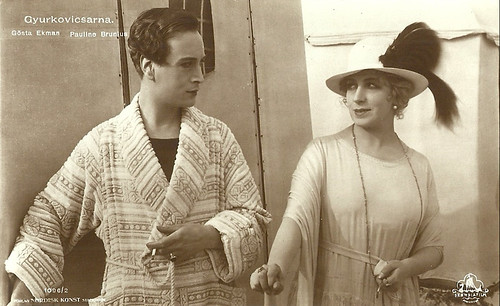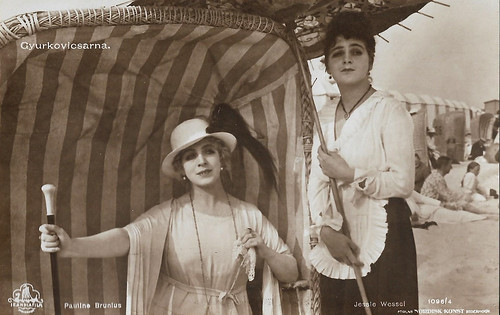Gösta Ekman and Pauline Brunius were the stars in the silent Swedish comedy Gyurkovicsarna/Lieutenant Tophat (John W. Brunius, 1920). Ekman and Brunius also wrote the script. For this Skandia Film production, Förlag Nordisk Konst in Stockholm made a series of six sepia postcards.

Swedish postcard by Forlag Nordisk Konst, Stockholm, no. 1096/1. Photo: Skandia Film. Gösta Ekman in Gyurkovicsarna/Lieutenant Tophat (John W. Brunius, 1920).

Swedish postcard by Forlag Nordisk Konst, Stockholm, no. 1096/2. Photo: Skandia Film. Gösta Ekman and Pauline Brunius in Gyurkovicsarna/Lieutenant Tophat (John W. Brunius, 1920).

Swedish postcard by Förlag Nordisk Konst, Stockholm, no. 1096/3. Photo: Skandia Film. Gösta Ekman and Violet Molitor in Gyurkovicsarna/Lieutenant Tophat (John W. Brunius, 1920).
The plot of Gyurkovicsarna/Lieutenant Tophat (John W. Brunius, 1920) evolves in Hungary. Mr. Gyurkovics (Julius Hälsig) and Mrs. Gyurkovics (Gucken Cederborg) have a dozen children of whom the eldest, the twins Géza (Gösta Ekman) and Bandi (Nils Asther), just preparing for their matriculation exam. When graduation day arrives, Géza refuses to come but is taken by force by the principal's attendant. When father Gyurkovics dies later, Bandi takes over the estate while Géza becomes an officer aspirant in the nearby garrison city.
Géza soon meets an angry colonel (opera singer Emil Stiebel) who puts him in his place. He goes to the restaurant and chases out all the other guests with his dragon sabre, for which he is arrested. Once out again, he immediately begins to make boys' streaks, is discovered by the colonel, and is chased around the regiment building. He takes refuge in a room where it appears that, at the top, the colonel's young daughter, Jutka (Violet Molitor), is sleeping. When the customary ball takes place in Baja, Géza awakens by continuously dancing with Jutka. The colonel orders a lieutenant to make sure the couple is divorced. The lieutenant executes the order such that Géza challenges him to a duel. None of them, however, are particularly keen to hurt the other and no accident occurs.
After a while Géza becomes under-lieutenant. He wins at card games and gets permission to visit a seaside resort, where he meets a general, a minister, and Freiherr Hetvics-Janky (Henrik Ljungberg). The Freiherr's wife (Pauline Brunius) is unhappily married and wants to provoke her husband to get a divorce. She immediately appeals to Géza and suggests that he will abduct her, as he would like to do.
Meanwhile, Mother Gyurkovic sends her son Bandi to the garrison city to keep an eye on Géza. Bandi meets Jutka and sweet love arises between them. Géza and the Freiherr's wife make a compromising train journey. Her husband, the field marshall, meets them on their trip, behaves extremely favourably to Géza, and refuses to be provoked. Thus, Géza avoids all obligations versus the intriguing Freiherr's wife. There will be a wedding between Bandi and Jutka. Among the wedding guests, there is Géza, who is happy to have failed to marry.
Gyurkovicsarna was a film adaptation of the novel 'A Gyurkovics-fiúk' by author Ferenc Herczeg. Exteriors were shot in Kalrberg and Falsterbo near Stockholm and Mölle, Skane, while interiors were shot at the Skandia studios in Stockholm. The film premiered on 20 September 1920 simultaneously at the cinemas Victoria in Göteborg, Skandiabiografen in Norrköping, Skandia in Västerås and the Sture-Teatern in Stockholm. The full film can be seen on Swedish Wikipedia.

Swedish postcard by Förlag Nordisk Konst, Stockholm, no. 1096/4. Photo: Skandia Film. Pauline Brunius and Jessie Wessel in Gyurkovicsarna/Lieutenant Tophat (John W. Brunius, 1920).

Swedish postcard by Förlag Nordisk Konst, Stockholm, no. 1096/5. Photo: Skandia Film. Gösta Ekman and Pauline Brunius in Gyurkovicsarna/Lieutenant Tophat (John W. Brunius, 1920).

Swedish postcard by Förlag Nordisk Konst, Stockholm, no. 1096/6. Photo: Skandia Film. Gösta Ekman and Pauline Brunius in Gyurkovicsarna/Lieutenant Tophat (John W. Brunius, 1920).

Swedish postcard by Förlag Nordisk Konst, Stockholm, no. 1096/7. Photo: Skandia Film. Nils Asther and Violet Molitor in Gyurkovicsarna/Lieutenant Tophat (John W. Brunius, 1920).
Sources: The Swedish Film Database, Wikipedia (Swedish), and IMDb.
This post was last updated on 31 July 2024.

Swedish postcard by Forlag Nordisk Konst, Stockholm, no. 1096/1. Photo: Skandia Film. Gösta Ekman in Gyurkovicsarna/Lieutenant Tophat (John W. Brunius, 1920).

Swedish postcard by Forlag Nordisk Konst, Stockholm, no. 1096/2. Photo: Skandia Film. Gösta Ekman and Pauline Brunius in Gyurkovicsarna/Lieutenant Tophat (John W. Brunius, 1920).

Swedish postcard by Förlag Nordisk Konst, Stockholm, no. 1096/3. Photo: Skandia Film. Gösta Ekman and Violet Molitor in Gyurkovicsarna/Lieutenant Tophat (John W. Brunius, 1920).
Happily not-married ever after
The plot of Gyurkovicsarna/Lieutenant Tophat (John W. Brunius, 1920) evolves in Hungary. Mr. Gyurkovics (Julius Hälsig) and Mrs. Gyurkovics (Gucken Cederborg) have a dozen children of whom the eldest, the twins Géza (Gösta Ekman) and Bandi (Nils Asther), just preparing for their matriculation exam. When graduation day arrives, Géza refuses to come but is taken by force by the principal's attendant. When father Gyurkovics dies later, Bandi takes over the estate while Géza becomes an officer aspirant in the nearby garrison city.
Géza soon meets an angry colonel (opera singer Emil Stiebel) who puts him in his place. He goes to the restaurant and chases out all the other guests with his dragon sabre, for which he is arrested. Once out again, he immediately begins to make boys' streaks, is discovered by the colonel, and is chased around the regiment building. He takes refuge in a room where it appears that, at the top, the colonel's young daughter, Jutka (Violet Molitor), is sleeping. When the customary ball takes place in Baja, Géza awakens by continuously dancing with Jutka. The colonel orders a lieutenant to make sure the couple is divorced. The lieutenant executes the order such that Géza challenges him to a duel. None of them, however, are particularly keen to hurt the other and no accident occurs.
After a while Géza becomes under-lieutenant. He wins at card games and gets permission to visit a seaside resort, where he meets a general, a minister, and Freiherr Hetvics-Janky (Henrik Ljungberg). The Freiherr's wife (Pauline Brunius) is unhappily married and wants to provoke her husband to get a divorce. She immediately appeals to Géza and suggests that he will abduct her, as he would like to do.
Meanwhile, Mother Gyurkovic sends her son Bandi to the garrison city to keep an eye on Géza. Bandi meets Jutka and sweet love arises between them. Géza and the Freiherr's wife make a compromising train journey. Her husband, the field marshall, meets them on their trip, behaves extremely favourably to Géza, and refuses to be provoked. Thus, Géza avoids all obligations versus the intriguing Freiherr's wife. There will be a wedding between Bandi and Jutka. Among the wedding guests, there is Géza, who is happy to have failed to marry.
Gyurkovicsarna was a film adaptation of the novel 'A Gyurkovics-fiúk' by author Ferenc Herczeg. Exteriors were shot in Kalrberg and Falsterbo near Stockholm and Mölle, Skane, while interiors were shot at the Skandia studios in Stockholm. The film premiered on 20 September 1920 simultaneously at the cinemas Victoria in Göteborg, Skandiabiografen in Norrköping, Skandia in Västerås and the Sture-Teatern in Stockholm. The full film can be seen on Swedish Wikipedia.

Swedish postcard by Förlag Nordisk Konst, Stockholm, no. 1096/4. Photo: Skandia Film. Pauline Brunius and Jessie Wessel in Gyurkovicsarna/Lieutenant Tophat (John W. Brunius, 1920).

Swedish postcard by Förlag Nordisk Konst, Stockholm, no. 1096/5. Photo: Skandia Film. Gösta Ekman and Pauline Brunius in Gyurkovicsarna/Lieutenant Tophat (John W. Brunius, 1920).

Swedish postcard by Förlag Nordisk Konst, Stockholm, no. 1096/6. Photo: Skandia Film. Gösta Ekman and Pauline Brunius in Gyurkovicsarna/Lieutenant Tophat (John W. Brunius, 1920).

Swedish postcard by Förlag Nordisk Konst, Stockholm, no. 1096/7. Photo: Skandia Film. Nils Asther and Violet Molitor in Gyurkovicsarna/Lieutenant Tophat (John W. Brunius, 1920).
Sources: The Swedish Film Database, Wikipedia (Swedish), and IMDb.
This post was last updated on 31 July 2024.
No comments:
Post a Comment